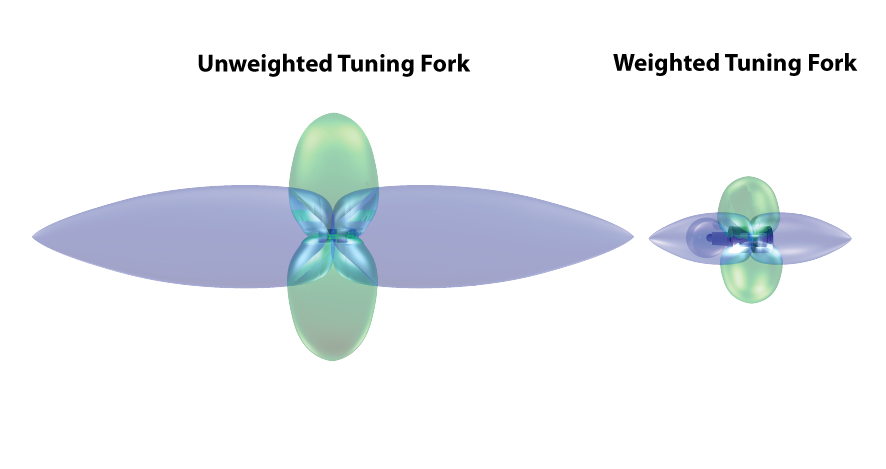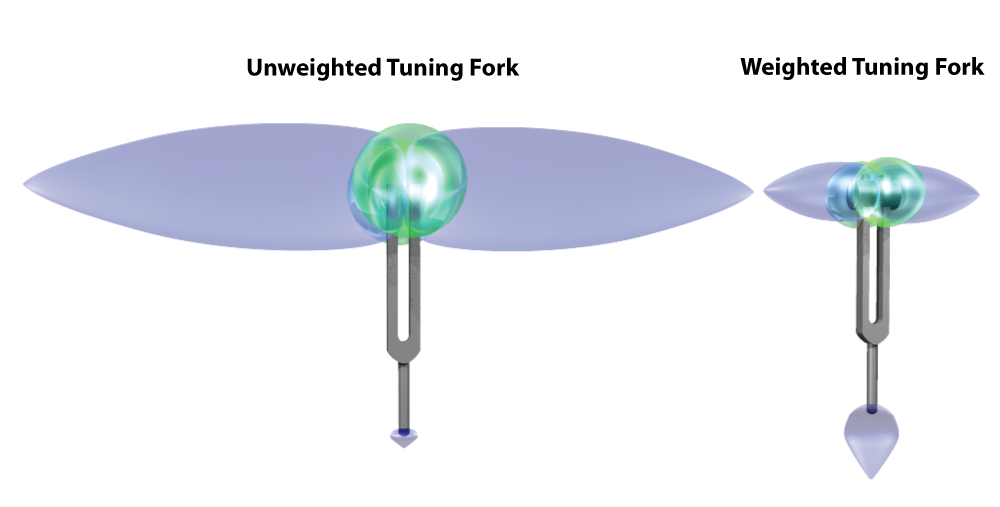During my 22 years in the Navy specializing in underwater acoustics, one of my jobs was to determine how far a particular vibration source would travel through water. Over the years I probably generated thousands of predictive models showing how sound travels in various parts of the ocean with a range of frequencies and sources. One type of predictive modeling involved a visual representation of sound traveling outwards from a source to determine where the sound stopped or dissipated beyond the detection capability of the sensor. As long as our Sonar sensors were within the colored “bubbles” then we should be able to detect and identify the source beyond the noise in the background.
I used a 3D modeling software to create a representation of the weighted and unweighted tuning forks to show how they are different in the way sound travels away from the forks. Obviously these images are a guess and not a direct representation of the actual range of a tuning fork.

What you can see in the images is the difference in the way an unweighted tuning fork is designed to send most of its vibration out into the air at the same direction as the moving tines. Some of the vibrations are sent out at a 90 degree angle to the tines, and very little vibration is available at the base of the fork. This is why NEHC does not use the unweighted tuning fork on the body.
The weighted tuning fork has weights on the tines to force most of the vibrations down the tines and into the stem. Although you can still hear the vibrations transmitting near the tines, the strongest vibrations are focused near the base. At our VFRT training, we also include a discussion about the weight distribution of the tuning forks and how the mechanical dynamics of these forks create additional bending of the metal to create many different oscillations beyond the stated frequency of the tine movement. The weights also add more torque to the tuning forks to make the stems flex and vibrate stronger due to the uneven weight distribution.
Dr. Daniel A. Russell, PhD., clarified this concept of parallel and perpendicular sound travel from tuning forks on a web page (see link below) he created for his graduate program in acoustics at The Pennsylvania State University. He shows the various modes of vibration travel from an unweighted 426hz tuning fork from a physics standpoint and included a polar plot to show how sound pressure levels (amplitude) are higher in the direction parallel to the tine movement compared to the perpendicular direction. I added more distance of useful vibration to the parallel direction to account for the added striking strength from a typical sound healer who uses tuning forks on a daily basis.
https://www.acs.psu.edu/drussell/Demos/TuningFork/fork-modes.html
In the article “Rinne test: does the tuning fork position affect the sound amplitude at the ear?” published in the Journal of Otolaryngology – Head and Neck Surgery, (2016) 45:21, Butskiy et al (see link below), research was conducted to determine “whether the orientation of the tuning fork tines affects the amplitude of the sound signal at the ear in clinical practice.” The Rinne test is typically used by clinicians as part of an otological physical exam to detect conductive hearing loss and requires a certain amount of sound intensity for diagnosis accuracy. The research concluded that the “sound intensity (sound-pressure level) recorded at the tympanic membrane with the 512 Hz tuning fork tines in parallel with as opposed to perpendicular [to the ear] was louder by 2.5 dB” and additional tests on other frequencies showed a range of 0.5 dB to 5.0 dB higher in the parallel direction compared holding a tuning fork perpendicular to the ear. They also determined that the decibel level differences were impacted by frequency mainly due to the length of the tines providing more physical force against the air molecules which translates into more sound pressure level leaving the tines. This is significant because in the acoustic world the distance sound can travel is doubled for every 3 dB increase in sound amplitude for an open area of transmission.
https://www.ncbi.nlm.nih.gov/pmc/articles/PMC4807550/pdf/40463_2016_Article_133.pdf
There is a right tool for the right job with tuning forks. Since unweighted tuning forks were designed to send vibrations into the air, this made the tuning fork a good tool for comparing two frequencies using your auditory system. The design of a weighted tuning fork was better suited for vibrating parts of the body mainly for medical diagnostic purposes. In VFRT, we use the weighted tuning fork to vibrate the tissue to create a change to the fascia collagen fibers in the outer layers and diffuse interstitial fluids (blood plasma) trapped in small pockets. This pressurization is what leads to sensations of pain and reduction in mobility.


